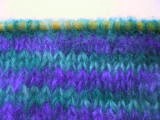


Yarn Profile: Ellen's 1/2-Pint Farm Hand-Dyed Mohair First Impressions
You may know Ellen from her profile in Candace Eisner Strick's Sweaters from New England Sheep Farms. From her rural Vermont farm, she hand-paints all her yarns in exquisite color combinations. She makes them available in small "sampler" skeins and massive project-sized bundles that could easily double as a cat. Knitting Up
If you knit with slightly exaggerated movements, you'll produce cleaner stitches and significantly lower your chances of any snagging. Having sidestepped those snags, I had no difficulties with this yarn. It knit up quickly and easily, producing a fuzzy, lightweight fabric. Blocking / Washing
I first washed the swatches in lukewarm water, with no bleeding whatsoever. I then subjected them to hotter water and more vigorous agitation. The color stayed true, and the swatches emerged fine. When I blotted the swatches in towels, they left no color there either. They blocked back to shape and the gauge stayed true. Success! Wearing
Only after undue thrashing did the swatches begin to flatten and look tired. This yarn wears relatively well against the skin, with only a small amount of brushed-mohair brassiness. The fuzz conceals individual stitches, letting your eye focus instead on the changing colors. In direct sunlight, the colors are punctuated by the natural sheen of mohair fibers. Conclusion
With Ellen's yarns, you know that each color was selected and applied with a careful eye for the finished result. Even her single-color skeins (available at festivals but not on her Web site) have slight color variations to add subtlety and depth to the finished garment. If you want to tone down the colors, you can simply pair her mohair with one strand of a foundation color, either knitting two strands together or alternating every few rows. But if you want something cheerful and highly original, pick one colorway and start knitting. Spinners beware: Ellen also sells hand-painted fibers! |
Yarn name
Hand-Dyed Mohair
Manufacturer
Ellen's 1/2-Pint Farm
Fiber content
78% mohair 13% wool 9% nylon
Gauge
None given on label, but I achieved 4 stitches per inch on US 8 needles
Average retail
price
$4.50 / small skein $65 / large skein
Where to Buy Online
Ellen's 1/2-Pint Farm
Weight/Yardage per Skein
1 oz. / 61 yards (small skein) 1 lb. / 980 yards (large skein)
Country of Origin
U.S.A.
Manufacturer's
suggested wash method
None given on label.
Review date
12/19/2001 |


